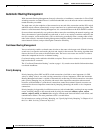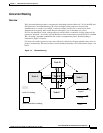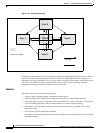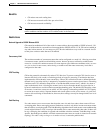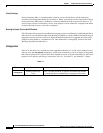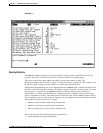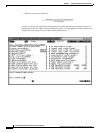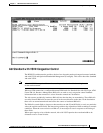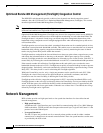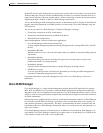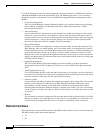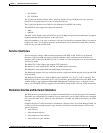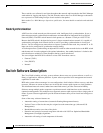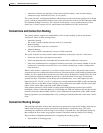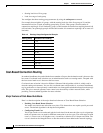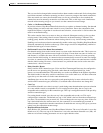
1-30
Cisco BPX 8600 Series Installation and Configuration
Release 9.3.10, Part Number 78-11603-01 Rev. D0, July 2001
Chapter 1 The BPX Switch: Functional Overview
Network Management
Optimized Bandwidth Management (ForeSight) Congestion Control
The BPX/IGX switch networks provide a choice of two dynamic rate-based congestion control
methods, Abr with VSVD and Cisco’s Optimized Bandwidth Management (ForeSight). This section
describes Optimized Bandwidth Management (ForeSight).
Note Optimized Bandwidth Management (ForeSight) is an optional feature that must be
purchased and enabled on a single node for the entire network.
Optimized Bandwidth Management (ForeSight) may be used for congestion control across BPX/IGX
switches for connections that have one or both endpoints terminating on cards other than BXM. The
ForeSight feature is a dynamic closed-loop, rate-based congestion management feature that yields
bandwidth savings compared to non-ForeSight equipped trunks when transmitting bursty data across
cell-based networks.
ForeSight permits users to burst above their committed information rate for extended periods of time
when there is unused network bandwidth available. This enables users to maximize the use of network
bandwidth while offering superior congestion avoidance by actively monitoring the state of shared
trunks carrying Frame Relay traffic within the network.
ForeSight monitors each path in the forward direction to detect any point where congestion may occur
and returns the information back to the entry to the network. When spare capacity exists with the
network, ForeSight permits the extra bandwidth to be allocated to active virtual circuits. Each PVC is
treated fairly by allocating the extra bandwidth based on each PVC's committed bandwidth parameter.
If the network reaches full utilization, ForeSight detects this and quickly acts to reduce the extra
bandwidth allocated to the active PVCs. ForeSight reacts quickly to network loading in order to prevent
dropped packets. Periodically, each node automatically measures the delay experienced along a Frame
Relay PVC. This delay factor is used in calculating the ForeSight algorithm.
With basic Frame Relay service, only a single rate parameter can be specified for each PVC. With
ForeSight, the virtual circuit rate can be specified based on a minimum, maximum, and initial
transmission rate for more flexibility in defining the Frame Relay circuits.
ForeSight provides effective congestion management for PVC's traversing broadband ATM as well.
ForeSight operates at the cell-relay level that lies below the Frame Relay services provided by the IGX
switch. With the queue sizes utilized in the BPX switch, the bandwidth savings is approximately the
same as experienced with lower speed trunks. When the cost of these lines is considered, the savings
offered by ForeSight can be significant.
Network Management
BPX switches provide one high-speed and two low-speed data interfaces for data collection and
network management:
• High-speed interface
An Ethernet 802.3 LAN interface port is provided for communicating with a Cisco WAN Manager
NMS workstation. TCP/IP provides the transport and network layer, Logical Link Control 1 is the
protocol across the Ethernet port.
• Low-speed interfaces
Two RS-232 ports are provided: one for a network printer and the second for either a modem
connection or a connection to an external control terminal. These low-speed interfaces are the same
as provided by the IGX switch.



